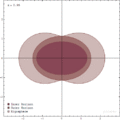Frame-dragging facts for kids
Frame dragging is a scientific idea about how space and time are connected. Scientists often call this connection "spacetime". This theory suggests that spacetime is like a stretchy fabric. Imagine a rubber sheet: if you push it, it bends, and when you let go, it springs back. In the same way, frame dragging says that tiny particles can share their energy with spacetime.
This idea helps answer big questions about things like gravity, the strong force (which holds atoms together), and wave-particle duality. Wave-particle duality is a tricky idea about how tiny things, like electrons, can sometimes act like waves and sometimes like particles.
Contents
What is Frame Dragging?
In the frame dragging theory, particles are always spinning. This spin has energy. Since spacetime is like a stretchy fabric, it can soak up some of this spin energy from the particle. When spacetime absorbs this energy, the particle's spin slows down.
How it Relates to Gravity
We all know that heavy objects attract other heavy objects. This is gravity. Scientists have found that mass can actually bend or curve spacetime around it. Think of a bowling ball placed on a trampoline; it makes a dip. If you roll a marble nearby, it will curve towards the bowling ball because of the dip.
Frame dragging suggests that when spacetime absorbs a particle's spin energy, it gets "bunched up" or curved. This curving of spacetime is what creates gravity from the particle's spin. The name "frame dragging" comes from the idea that spinning particles "drag" or "grab" spacetime as they spin. This means not only space but also time would be curved.
It's important to know that this "gravity" from frame dragging is different from the normal gravity caused by an object's mass. Frame dragging happens when one object moves or spins near another. It makes both objects change their movement because of the other's motion. If an object isn't spinning or moving, frame dragging doesn't happen.
Wave-Particle Duality Explained
Scientists like Einstein and Schrödinger wondered how tiny things, like electrons, could act like both a wave and a particle. Frame dragging offers an answer.
Since spacetime is stretchy, it can also give the spin energy back to the particle. When the particle gets all its spin energy back, it acts most like a wave. Then, it starts using its energy again to bunch up spacetime. When the particle is no longer spinning, it acts most like a particle. This cycle keeps going forever, with no energy lost, thanks to the conservation of energy. This is how a particle can act like a particle and a wave almost at the same time.
The Strong Force
Frame dragging also helps explain the strong force. This is the powerful force that holds protons and neutrons together inside the center (the nucleus) of an atom.
The theory suggests that if two particles are close to each other, they can save energy. This happens if one particle is absorbing energy from spacetime while the other is giving energy back to spacetime. This energy exchange can even increase the mass of both particles, following Einstein's famous idea that energy and mass are connected. This encourages particles to stick together, which explains why the strong force is so powerful.
Evidence for Frame Dragging
Scientists are testing ideas that come from the math of the frame dragging theory. One idea is that if a small spinning object orbits a larger spinning object, the smaller object's spin axis (the imaginary line it spins around) will slowly try to line up with the larger object's spin axis. This is called the Lense-Thirring effect.
To test this, scientists have sent a gyroscope (a device that usually keeps its spin axis steady) into orbit around the Earth. They are checking if the gyroscope's spin axis slowly lines up with Earth's spin axis. So far, scientists have found evidence that supports the Lense-Thirring effect, and possibly the frame dragging theory, with very high accuracy.
Images for kids
-
This image shows the areas around a spinning black hole. The outer pumpkin-shaped area is where spacetime is dragged along by the black hole's spin.


